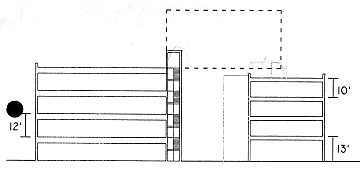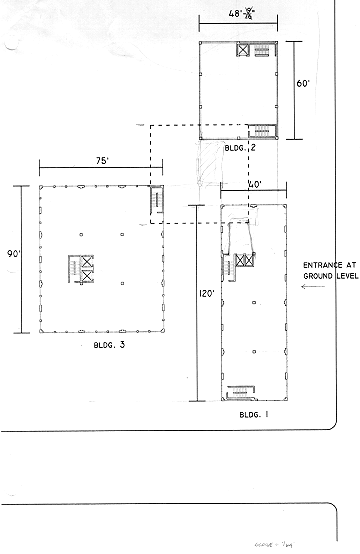|
TRIPOD BUILDING
GSD 1101 / Introduction to Design and Visual Studies in Architecture / Fall ’04
Scott Cohen, coordinator
Timothy Hyde
Jeannie Kim
Sam Lasky
Michael Meredith
Thomas Schroepfer
Marco Steinberg
Project #3: Tripod Building
The project is to design a building, most of which is suspended five stories over a gap between three buildings. The proposed building will serve as the center of an institute for advanced studies located above a small, existing complex comprising its study and office facilities.
Project Narrative
The institute finds itself faced with an architectural problem. Though there is a demand for new and distinctive spaces that will both unify it and provide a significant place for contact between its members and the public, its current facilities preclude a straightforward solution. Its three buildings are not related in any coherent way, having originally served various indiscernible commercial and industrial functions. The space between them, providing the only outdoor space for possible communication or encounter, must serve as a right of way between parts of the campus beyond. Thus it would appear that the institute, a community unto itself, can neither encompass its own between-space nor become coherent by means of filling it and linking its three disparate parts.
Making matters somewhat more difficult is a decision to maintain a single public entrance in order not to compromise a clear relationship to the public domain. Though the institute would benefit from free circulation between its buildings, there are practical, primarily security related reasons that the buildings cannot each be open to the public; it would not be reasonable to station guards at entrances to all three buildings. Moreover, the spaces inside the buildings are rather small and demand that each building have access to light on all sides. An addition located between the existing facilities could not provide a significant space without compromising them. It seems that any addition that connects the buildings would therefore need to be rather narrow and limitedly circulatory. The addition of a significant public space would have to be made at the periphery of the institute. Yet those sites are, for various reasons, not available to the institute.
Given these limitations, the site chosen for the proposed solution is suspended above. It will connect the three buildings such that it relates architecturally to each of them in radically different ways. The first building continues to serve as public entry to the complex. Its roof provides the means of entry to the new center. The second building provides a roof garden. The third building is somewhat taller than the other two. One of its egress stairs will extend into the corner of the new building.
Admittedly, this is an unusual situation. Yet, in certain respects the problem is not unlike that of many conditions in which architecture is required to redefine, unify or conceal antithetical motives and needs. Such cases are often immersed in an urban morphology with which the organizational needs of an institution are not altogether compatible. In other cases, disparities of scale or alignment between exterior volumetric configuration, facade fenestration, structure, individual rooms and sequences of the interior, may be attributed to causes which, though not directly related to urban form, nevertheless establish analogous difficulties.
Context
The complex is located in a hypothetical extension proposed for a hypothetical campus, presumably in a district that resembles areas of Allston at the periphery of the proposed Harvard campus expansion. The existing complex includes several buildings built at different times. They were modified incrementally to serve the institute. The distinction between original and modified parts is not represented here. The age, type and construction technology of each building is to be determined according to the clues provided by the plan. As a partial piece of documentation, the given plan asks many questions which require us to work as if archeologists, genealogists, or tailors analyzing an incomplete pattern or template. Among the tasks of this project, therefore, is to comprehend, disclose and reinvent the presumably existing buildings from the available clues.
The Program
The program is comparable to that of the Radcliffe Institute for Advanced Study. The existing complex includes a small library, offices, lecture rooms and studios. The proposed addition will include an outdoor exhibition space, exhibition/lecture/dining hall, two seminar rooms, six new studios for six artists and six additional scholars’ offices. A portion of the exhibition space should additionally serve as a space for instruction, lectures and dinner events.
Exhibition/lecture/dining hall: 2500 sf
2 seminar rooms, 300 sf each: 600 sf
6 studios, 400 sf each: 2400 sf
6 offices, 150 sf each: 900 sf
2 bathrooms, 60 ft each + circulation: 1100 sf
Exterior roof sculpture garden (on top of building #2)
Total interior space: 7500 sf
Maximum footprint, excluding connection to building #1: 60' x 60'
Maximum height above building #3: 30'
Presentation Requirements:
Three plans, three sections minimum: 1/8" = 1'
Model: 1/4"= 1' or 1/8"=1'
Minimum two Tri-metrics or perspectives
Schedule:
Project issued: Friday, November 12, 2004
Final review: Tuesday, December 21, 2004, 9 – 6 PM

(The black circle on the left is from a hole in the 3-ring binder paper.)

|